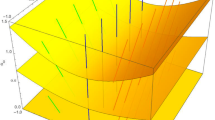Abstract
In the context of a covariant mechanics with Poincaré-invariant evolution parameter τ, Sa'ad, Horwitz, and Arshansky have argued that for the electromagnetic interaction to be well posed, the local gauge function of the field should include dependence on τ, as well as on the spacetime coordinates. This requirement of full gauge covariance leads to a theory of five τ-dependent gauge compensation fields, which differs in significant aspects from conventional electrodynamics, but whose zero modes coincide with the Maxwell theory. The pre-Maxwell fields may exchange mass with charged particles, permitting pair annihilation even at the classical level. The total mass-energy-momentum tensor of the fields and particles is conserved. The Green's functions for the fields provide spacelike and timelike support for correlations, as well as lightlike propagation. A τ-integration of the fields—singling out the massless photons—recovers the standard Maxwell theory, which then has the character of an equilibrium limit of the underlying microscopic dynamics. The pre-Maxwell theory also turns out to be the solution of the inverse problem in variational mechanics: it is shown to be the most general local gauge theory consistent with unconstrained commutation relations in four dimensions. Posed in this framework, the extension to n-dimensions, curved background space, and non-abelian gauge symmetry becomes straightforward.
Similar content being viewed by others
REFERENCES
R. P. Feynman, Phys. Rev. 80, 4404 (1950); Rev. Mod. Phys. 20, 367 (1948).
J. Schwinger, Phys. Rev. 82, 664 (1951).
E. C. G. Stueckelberg, Helv. Phys. Acta 14, 322 (1941); 14, 588 (1941).
D. Saad, L. P. Horwitz, and R. I. Arshansky, Found. of Phys. 19, 1126 (1989).
A. Kyprianidis, Phys. Rep. 155, 1 (1987).
L. P. Horwitz and Y. Lavie, Phys. Rev. D 26, 819 (1982). R. I. Arshansky and L. P. Horwitz, J. Math. Phys. 30, 213 (1989); Phys. Lett. A 131; 222 (1988).
R. I. Arshansky and L. P. Horwitz, Phys. Lett. A 30, 66 (1989).
R. Arshansky and L. P. Horwitz, J. Math. Phys. 30, 380 (1989).
M. C. Land, R. Arshansky and L. P. Horwitz, Found. Phys. 24, 563 (1994).
M. C. Land and L. P. Horwitz. J. Phys. A: Math. Gen. 28, 3289 (1995).
M. C. Land and L. P. Horwitz, Found. Phys. Lett. 4; 61 (1991).
L. P. Horwitz and C. Piron, Helv. Phys. Acta 48, 316 (1973).
M. C. Land and L. P. Horwitz, Found. Phys. 21, 299 (1991).
S. A. Hojman and L. C. Shepley, J. Math. Phys. 32, 142 (1991).
M. C. Land, N. Shnerb, L. P. Horwitz, J. Math. Phys. 36, 3263 (1995).
S. K. Wong, Nuovo Cimento A 65, 689 (1970).
R. Arshansky, L. P. Horwitz and Y. Lavie, Found. Phys. 13, 1167 (1983).
N. Shnerb and L. P. Horwitz, Phys. Rev. A 48, 4068 (1993).
M. C. Land, Found. Phys. 27, 299 (1997).
J. Frastai and L. P. Horwitz, TAUP-2138-94.
W. Pauli and F. Villars, Rev. Mod. Phys. 21, 434 (1949).
Rights and permissions
About this article
Cite this article
Land, M.C. Pre-Maxwell Electrodynamics. Foundations of Physics 28, 1479–1487 (1998). https://doi.org/10.1023/A:1018813429428
Issue Date:
DOI: https://doi.org/10.1023/A:1018813429428




